How Many Parking Spaces Are Required for a Commercial Building?
Have you ever stopped to wonder how many parking spaces are required for a commercial building? Are you perhaps considering installing a parking lot outside of your commercial building, but aren’t sure how many spaces you need? These are simple questions, but the answers are a bit complicated.
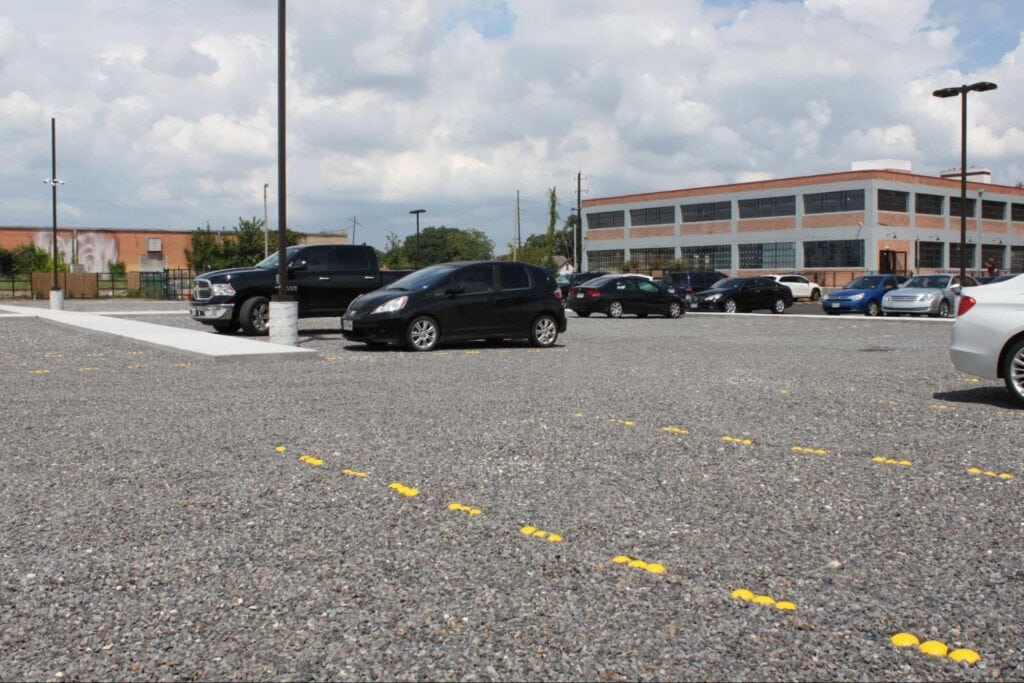
A proper parking solution is vital for any commercial venture, but determining the exact number of spaces required can be a little complex. Let’s explore how you can create a parking solution that’s perfect for your business.
Why Do Commercial Buildings Need Parking Lots?
Parking lots are integral to commercial buildings. They serve as the gateway for employees, customers, and visitors. A commercial building without a properly planned parking area is like a stage without an entrance. It’s also a missed opportunity to make a strong first impression.
The necessity of parking lots extends beyond impressions. They’re a beacon of convenience, accessibility, and security. A well-lit and easy-to-navigate parking lot can attract more customers, enhance their overall experience, and ensure safety. It’s more than just an added feature for your building. It’s also a critical feature that can directly impact your business’s success.
However, the original question is one of the first you have to answer. How many parking spaces are required for a commercial building? The answer depends on a bunch of different factors and isn’t as straightforward as you might expect.
How Many Spaces Do You Need?
When calculating parking spaces, there’s a general guideline to follow. Office spaces typically need about four parking spots for every 1,000 square feet of the commercial building. It’s important to remember that this is a general rule, and the specific requirements might vary depending on your building’s location and the type of commercial activity it sees.
Understanding the concept of a parking ratio can help refine your calculation. A parking ratio is essentially a ratio of the available parking spaces to the property’s gross leasable area (GLA). For instance, a 20,000-square-foot office building with 100 parking spaces has a parking ratio of five spaces per 1,000 square feet.
Cities and municipalities often have commercial zoning ordinances that set minimum parking ratios, which can vary based on the type of commercial property. If you’re in doubt about how many parking spaces are required in your area, that’s where you should start.
Specialized Parking Spaces and Accessibility
As you plan out your commercial parking lot, you must also consider specialized parking spaces and accessibility. In fact, accessibility needs to be a priority.
Handicapped parking spaces, equipped with proper signage and located near the entrance, will help ensure that your building is accessible to all. Electric vehicle charging points, on the other hand, show foresight and a commitment to sustainability.
Special zones for delivery vehicles can help ensure smooth operations, while designated spaces for emergency responder vehicles demonstrate preparedness. Designing your parking lot is not just about providing spaces for your customers and employees. It’s also about inclusivity, sustainability, and safety.
The Downsides of Concrete Parking Lots
Concrete parking lots may seem like the go-to choice, but they aren’t without their flaws. Here are some issues to consider:
Poor Drainage
Concrete is impermeable. During a heavy rainfall, water can pool and flood your parking lot, which creates both a safety hazard and a nuisance.
Heat Absorption
Concrete absorbs and radiates heat, and it makes the ground super hot. This widespread effect across urban centers can increase local temperatures and contribute to global warming.
Maintenance
Concrete cracks and deteriorates over time, and requires regular and sometimes, expensive repairs.
Exploring Alternative Parking Lot Options
Fortunately, innovative alternatives to concrete parking lots are available. A standout option is permeable pavers.
Permeable paving systems are designed to allow water to pass through their surface, which can significantly reduce the risk of flooding and can promote groundwater recharge. Switching to a permeable parking solution is a small shift that can significantly impact the local environment and the long-term sustainability of your commercial property.
The Benefits of Permeable Pavers
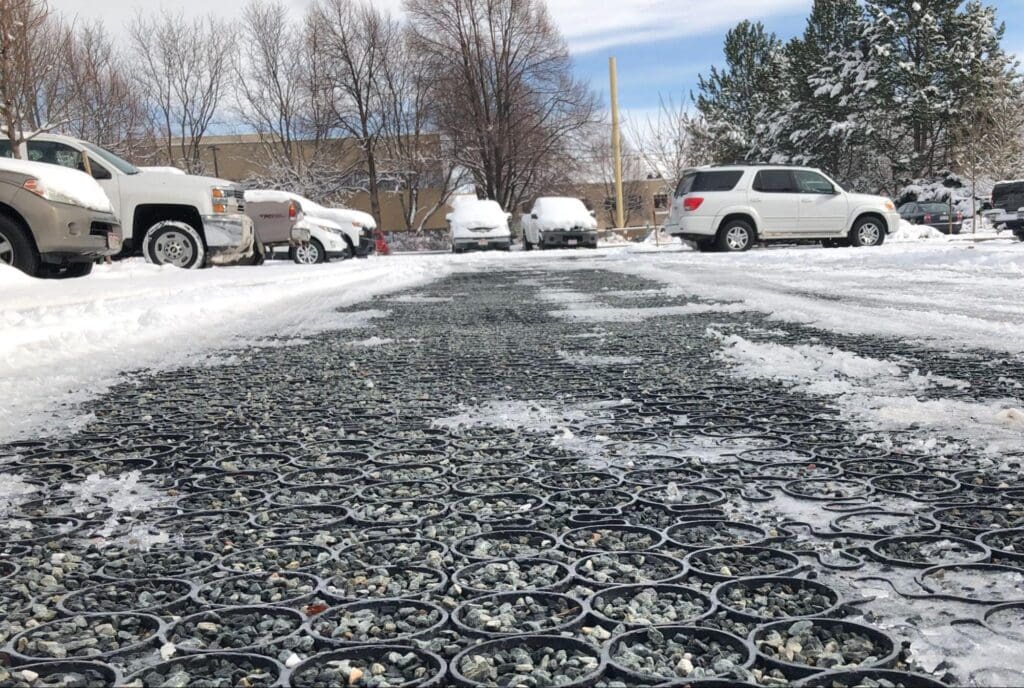
The beauty of permeable pavers lies not only in their eco-friendliness, but also in their wide-ranging benefits:
Proper Drainage
Permeable pavers facilitate effective stormwater management, reduce surface runoff and prevent standing water.
Strength and Durability
Designed for resilience, permeable pavers can withstand heavy traffic and inclement weather. They’re a long-lasting solution designed for heavy use over an extended period of time, which makes them uniquely beneficial for commercial parking lots.
Affordability
Permeable parking lots are significantly less expensive than concrete parking lots, both in terms of installation and long-term maintenance.
Ease of Installation
Permeable pavers are easy to install and replace if damaged, which makes them ideal for commercial buildings.
Versatility
Permeable pavers can be seamlessly integrated with grass for landscape parking, so if you have overflow or want to turn large grassy areas into parking spaces, permeable pavers are the perfect option!
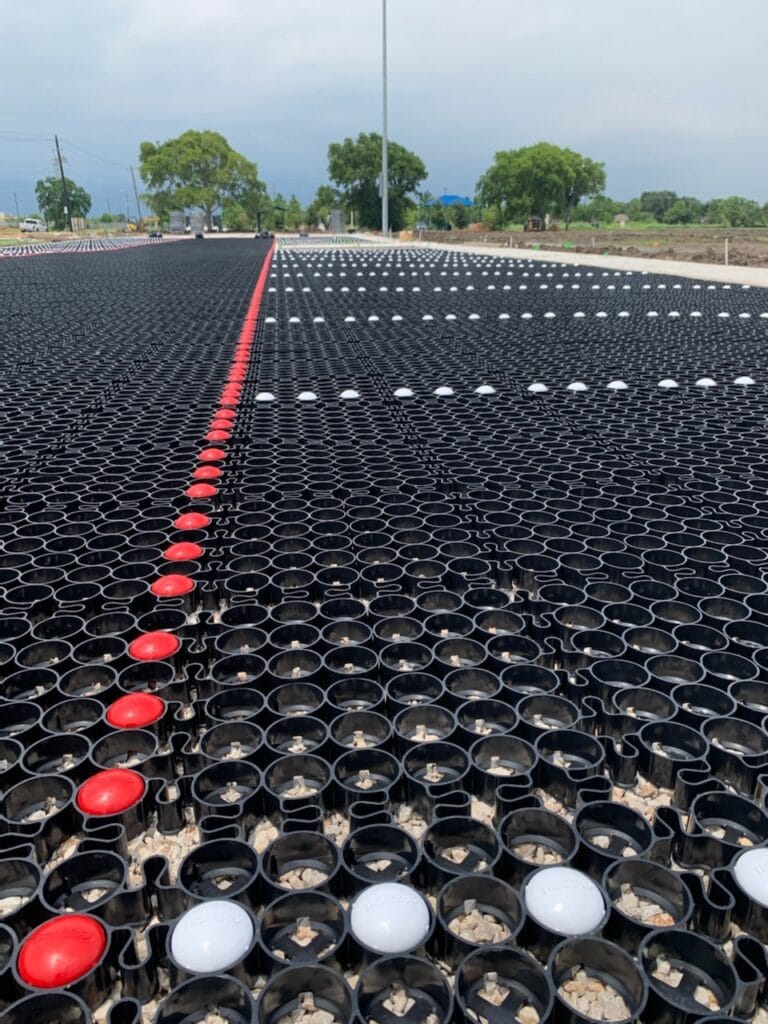
Delineation
An innovative alternative to striping for permeable pavers are SuperSpot®s and SnowSpots. These insets are long lasting, highly visible, and configurable for nearly any parking lot setting. Simply place the “spot” in an empty grid cell in place of painted stripes. TRUEGRID®’s delineators will last the life of the parking lot with no need for replacement or maintenance. SuperSpot®s are raised above the grid for use in warm climates or for high-visibility. SnowSpots, when installed, are flush level with the top of the PRO PLUS® and can be used in cold climates where snow plowing is common.
Get Permeable Pavers for Your Commercial Building Parking Lot
Calculating how many parking spaces are required for a commercial building is just the beginning. The real challenge lies in creating a parking solution that’s functional, inclusive, and sustainable. Permeable pavers are an excellent alternative to traditional concrete parking lots, that provide efficient parking and also contribute to a greener and more sustainable environment.
Ready to take the next step toward a smarter parking solution? Let’s create a parking lot that serves your needs and benefits the environment. Contact us for an estimate today!
Are you considering installing a concrete parking lot but aren’t sure how much it costs?
Unfortunately, figuring out how much a parking lot costs is not as straightforward as you might think because there are a lot of hidden fees that you might not know about. We created this guide to help you with both the visible and hidden costs of installing concrete parking lots, to help you understand what you should expect to pay.
Concrete is the Traditional Parking Lot Material
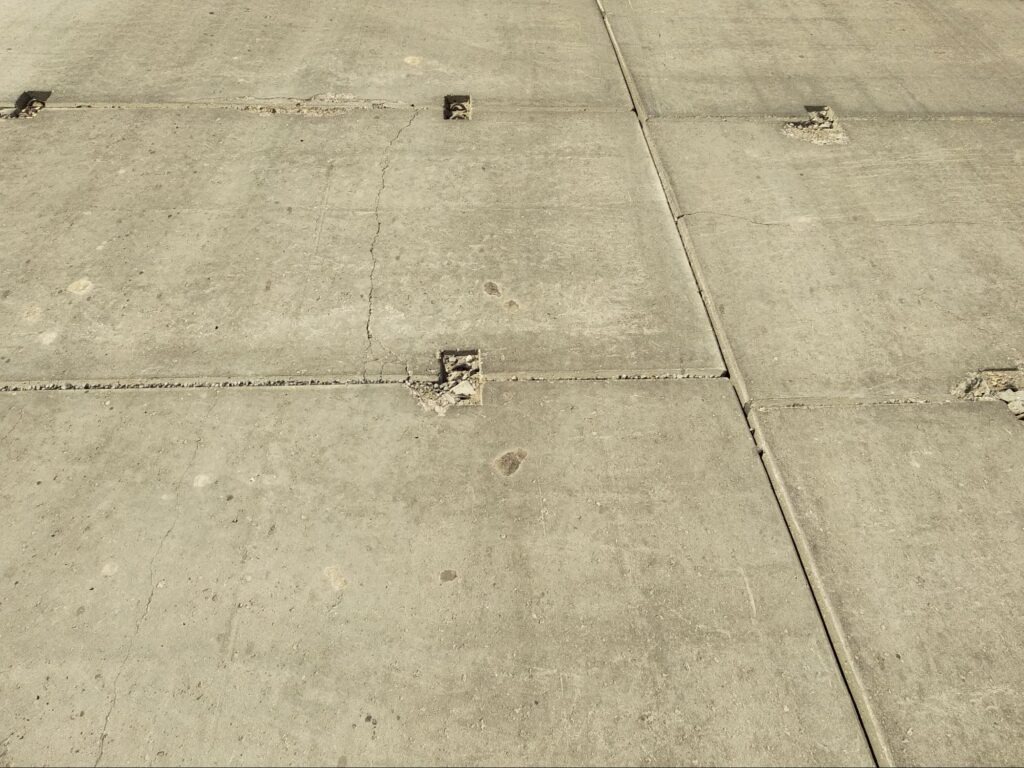
Concrete parking lots are the unsung heroes of our urban landscape that provide reliable spaces for vehicles all over the world. Crafted out of cement, water, and other aggregates, they are popular for their durability and endurance. However, beneath their rough and tough exterior lies a pretty substantial investment.
How Much Do Concrete Parking Lots Cost?
To understand concrete parking lot costs, we must examine two primary factors. The first one is the cost per square foot. On average, you can expect to pay between $7 and $12 per square foot, factoring in materials and labor costs. That’s just the tip of the iceberg, though.
Consider the cost per parking spot for a more specific estimate. For a small six-spot lot, you’ll likely have to invest between $5,000 and $14,000, which isn’t a small sum.
Need to accommodate more vehicles? A 200-spot lot might cost between $174,000 and $490,000. Concrete parking lots are a significant undertaking, with costs scaling according to your project’s size. If the cost surprises you, we get it. Let’s dive into the specifics to understand how cost is determined.
Costs to Consider When Installing a Concrete Parking Lot
Building a concrete parking lot involves several key costs that may seem a bit obvious, but just in case, here’s a breakdown of the common and most obvious costs you need to consider when installing a concrete parking lot:
Installation Costs
The first and most obvious are the installation costs. Installation costs include the costs of labor and raw materials. Your budget needs to account for the experts who prepare the site, lay the concrete, and apply the finishing touches. The cost of the concrete itself, along with any necessary reinforcements and sealants, also falls under this category.
Lot Size
The size of the parking lot also impacts the final cost. As logic would dictate, a larger lot requires more concrete and workers, which increases the overall cost. It might also need additional or specialized equipment, which can further inflate your budget. On the other hand, a smaller lot can be less expensive to install, but could present challenges in terms of space and layout.
Materials
Another visible cost is the choice of materials. If you choose a higher-quality concrete, you might have to shell out more initially. However, it can pay off in the long run thanks to the superior durability and longer life expectancy of a higher-grade material.
These are the most common costs that are immediately visible. There are also hidden costs that might pop up and unexpectedly blow up your budget.
Hidden Costs Associated with Concrete Parking Lots
Beyond the obvious costs are several hidden factors that could throw your budget off course, including:
Number of Installation Phases
A concrete parking lot installation might need to be broken up into several phases, depending on the project complexity and size. More phases mean extended labor hours, which could result in higher costs.
Location
If your suppliers are far from your project site, transporting the materials could significantly add to your project’s overall expenses. The longer the distance, the higher the transport costs.
Traffic Control
If your parking lot is in a busy area, you might need to consider traffic management during construction. This could require additional resources or even a dedicated team, which can add to the project cost.
Gas Prices
In today’s volatile market, gas prices can significantly affect your project’s cost. Fluctuating fuel costs can impact the cost of transporting materials and operating machinery.
Drainage Requirements
Every parking lot needs a proper drainage system to avoid water accumulation. Installing the right drainage can require additional construction work and materials, which could increase the overall cost.
Cleaning Costs
Maintenance is a crucial but often overlooked aspect of owning a parking lot. Regular cleaning tasks, such as power washing and stain removal, add to the ongoing expense.
Lighting Requirements
Adequate lighting is essential for a parking lot for security and visibility. Installing and maintaining lighting fixtures can add significantly to the cost.
Being aware of these potential hidden costs can give you a clearer picture of the actual costs involved in installing a concrete parking lot. Plus, you won’t be blindsided when you start running over budget!
Permeable Pavers vs. Concrete Parking Lots
If the cost of a concrete parking lot is discouraging, you’re in luck! Permeable pavers are a viable, cost-effective, and environmentally-conscious alternative to concrete parking lots. Permeable pavers often cost less to install than their concrete counterparts, and they’re incredibly durable, which reduces the frequency and cost of maintenance.
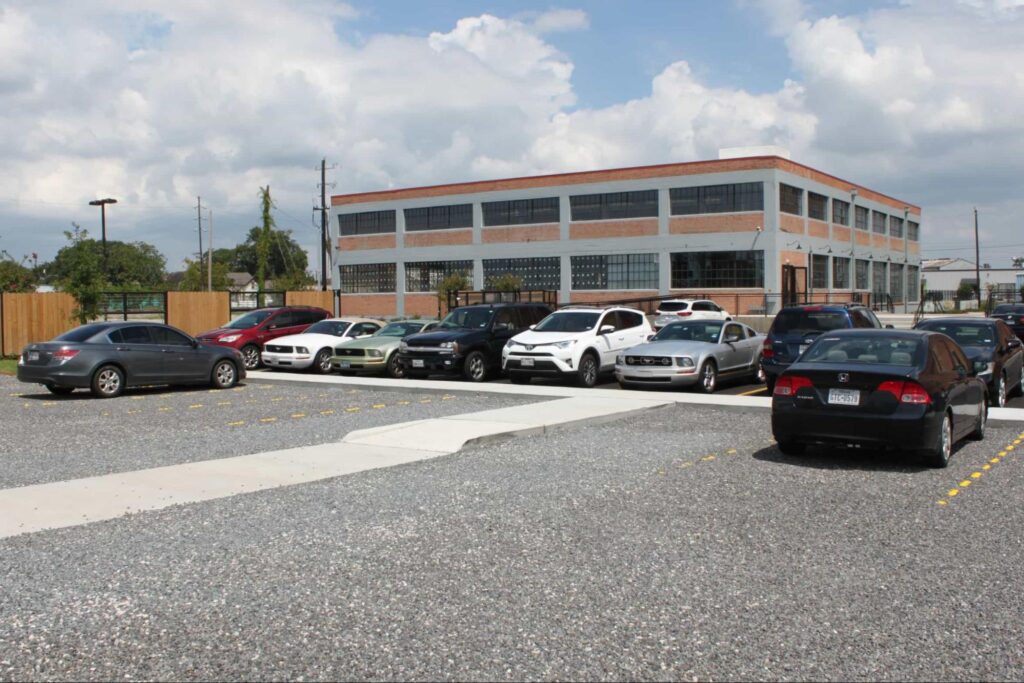
The real beauty of permeable pavers lies in their design. Unlike concrete, they allow water to seep through, which minimizes the need for extensive drainage systems. They also help to mitigate potential flooding and reduce the burden on municipal water management systems.
Upgrade Your Parking Lots with TRUEGRID Permeable Pavers
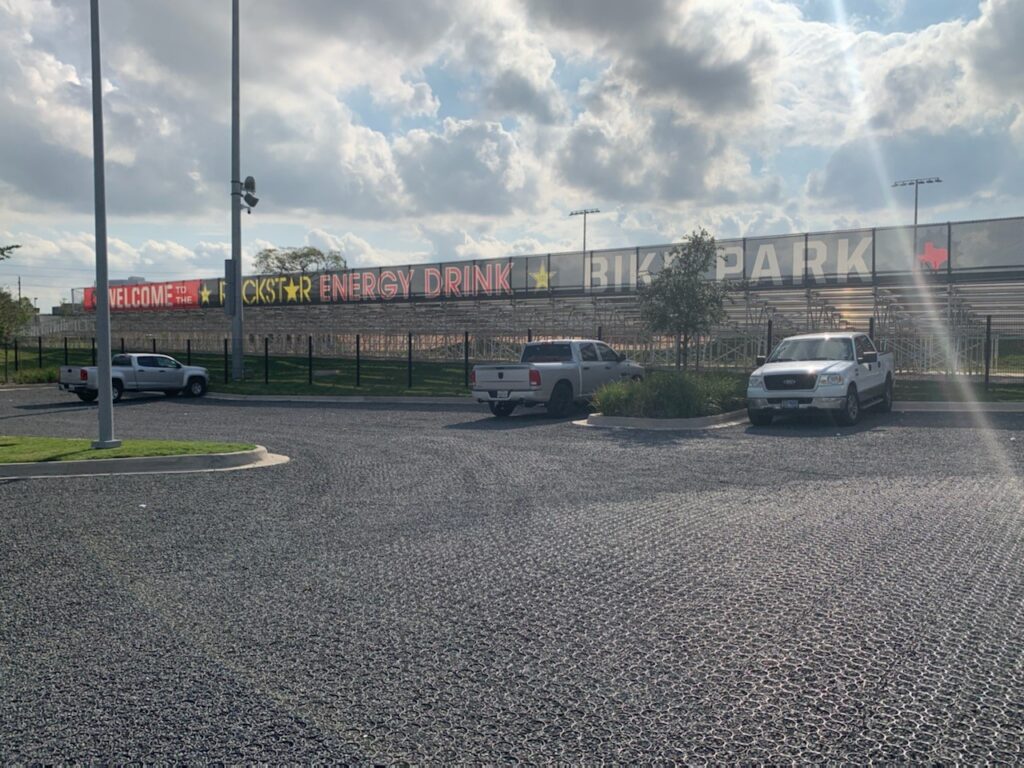
It’s time to say goodbye to hidden concrete parking lot costs and embrace the advantages of permeable pavers. Don’t let unexpected expenses hijack your project. Instead, opt for a solution that’s smart, sustainable, and more cost-effective.
Are you ready to take the plunge into the world of permeable pavers? Reach out for an estimate on your project today!
Are you thinking about giving your driveway a much-needed makeover with crushed limestone? This lesser-known paving option packs a punch with an array of benefits that could make it perfect for your home.

That’s why we’ve created this comprehensive guide, to delve deep into the pros and cons of crushed limestone driveways. Our goal is to give you a thorough overview to help you make an informed decision about the type of material that’s right for your home. Let’s get started!
What Are Crushed Limestone Driveways?
Crushed limestone driveways are constructed predominantly from finely crushed limestone. This sedimentary rock, notable for its distinctive grey hue, is packed tightly to form a sturdy and visually pleasing driveway surface that embodies a hint of rural charm.
Crushed limestone driveways work because they create a permeable surface. The gaps between the compacted stones allow water to seep through, which reduces surface runoff and contributes to a more eco-friendly driveway option. They’re also a natural and sustainable choice for anyone passionate about doing their part to preserve our planet.
Pros for Crushed Limestone Driveways
Crushed limestone driveways are more than just easy on the eyes. They also provide functional benefits that can make your life easier. From enhancing your home’s aesthetic appeal to more practical advantages, there’s plenty to appreciate. Here are the pros for crushed limestone driveways.
Better Drainage
One standout feature of crushed limestone driveways is their superior drainage capabilities. The porous nature of limestone lets water drain through quickly, to prevent water logging or standing water. If you live in a region that gets lots of rain, this feature can be a game-changer that saves you from dealing with a water-logged driveway.
Easy Installation
Another benefit of crushed limestone driveways is the ease of installation. The process is relatively straightforward and can even be accomplished by an amateur DIYer. Simply layer the crushed limestone, compact it, and you’re done! It’s really that simple.
Durability
Durability is a significant factor when choosing a driveway material, and crushed limestone doesn’t disappoint. The robust nature of limestone creates a driveway that can withstand the weight of heavy vehicles and regular foot traffic. There’s no need to worry about longevity because a crushed limestone driveway is a reliable, long-term investment.
Aesthetics
We can’t skip over one of the biggest attractions of crushed limestone driveways – their aesthetic appeal. The natural beauty of the stone, with its striking grey color, can enhance any property’s visual appeal. If you’re looking for a way to elevate your home’s exterior, a crushed limestone driveway is a fantastic option.
Affordability
Crushed limestone is a highly cost-effective choice for driveway material. You get a durable, attractive, and functional driveway without burning a hole in your pocket, which makes crushed limestone a standout option for budget-conscious homeowners.
Cons for Crushed Limestone Driveways
However, crushed limestone driveways aren’t without their drawbacks. Like any material, they have their own cons. Here are some of the disadvantages of choosing a crushed limestone driveway:
Seasonal Changes
In regions that experience significant seasonal changes, crushed limestone driveways can be a bit of a challenge. Freeze and thaw cycles can cause the driveway to shift and become uneven. It may require some work to keep the surface level and functional.
Regular Maintenance
Maintenance is another important factor to consider. Crushed limestone driveways require regular upkeep, which can involve adding new limestone to compensate for occasional settling or compacting of the driveway. It could be a deterrent if you don’t enjoy occasional manual work. Unsupported crushed limestone can also get embedded in tire treads and deposited offsite creating ruts or tire divots needing periodic refilling.
Durability (Compared to Other Materials)
Despite limestone’s durability, it doesn’t quite match up to materials like concrete or asphalt in terms of strength. Under the pressure of heavier vehicles, the limestone may shift, and create an uneven surface. If your driveway frequently bears heavy loads, this could be an important factor.
Impact on Tires
Crushed limestone can be tough on tires, especially if the stones are incorrectly packed. Over time, it can lead to faster wear and tear on your vehicle tires. If you’re conscious about prolonging the life of your tires, you should probably pay special attention to how your crushed limestone is compacted.
Time-Consuming Installation
While the installation process is relatively simple, it’s not quick, particularly for larger driveways. You may find yourself spending a weekend or two on your project, which can be a bit of a challenge for those with a busy schedule.
A Crushed Limestone Driveway Alternative – Permeable Pavers
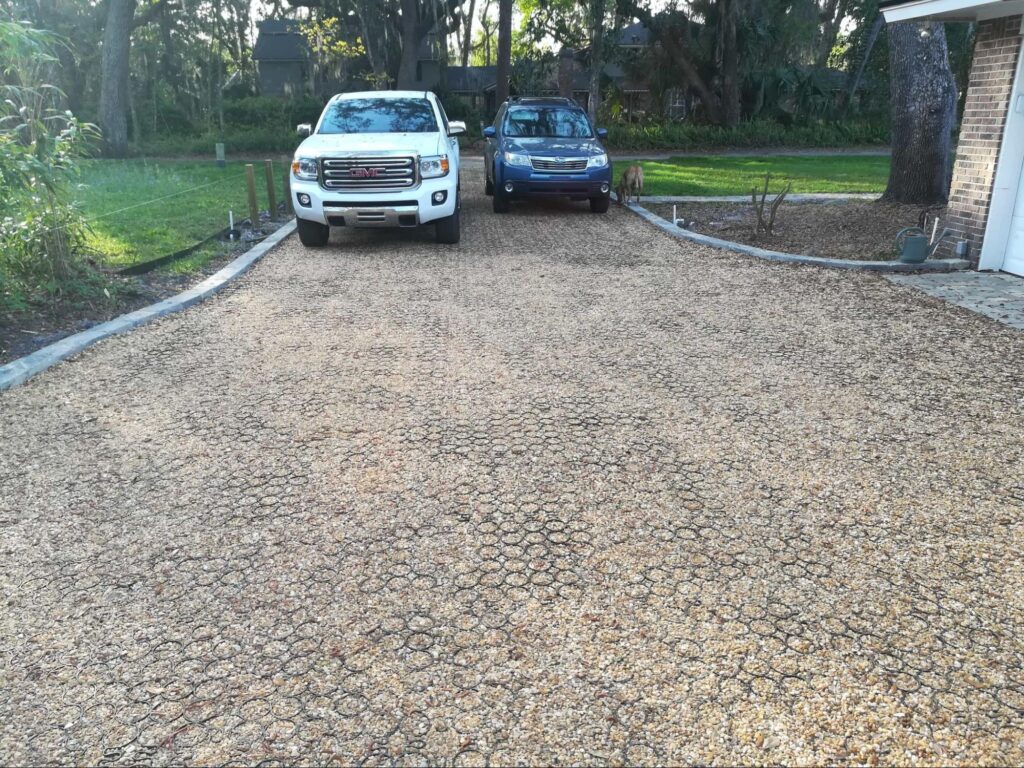
Now that we know the pros and cons of crushed limestone, it’s important to note that crushed limestone isn’t the only permeable driveway option. What if you could enjoy the benefits of a permeable driveway without the drawbacks of loose crushed limestone? Meet TRUEGRID® Permeable Pavers! Our revolutionary pavers provide the benefits of crushed limestone with a sprinkle of additional advantages.

TRUEGRID®’s permeable pavers offer durability, longevity, and cost-effectiveness. They require less maintenance than crushed limestone driveways. The gravel fill is protected by the TRUEGRID cells and walls and will not “walk-away” in tire treads.
Their aesthetic appeal and eco-friendly design make for a superior driveway solution, which makes them the perfect alternative to crushed limestone. You get all the benefits and none of the drawbacks!
Learn More About TRUEGRID® Permeable Pavers Today!
Crushed limestone driveways have a unique charm, but TRUEGRID® permeable pavers bring much more to the table. With their combination of durability, aesthetic appeal, and environmental benefits, they’re an investment every homeowner should consider.
Don’t wait to upgrade your home’s driveway. Reach out today for an estimate on your project. Your dream driveway is just a click away!
Does your heart sink a little every time you see tire tracks on your carefully maintained lawn? Overflow parking can cause severe damage to your grass, but thankfully, you’re not without options.
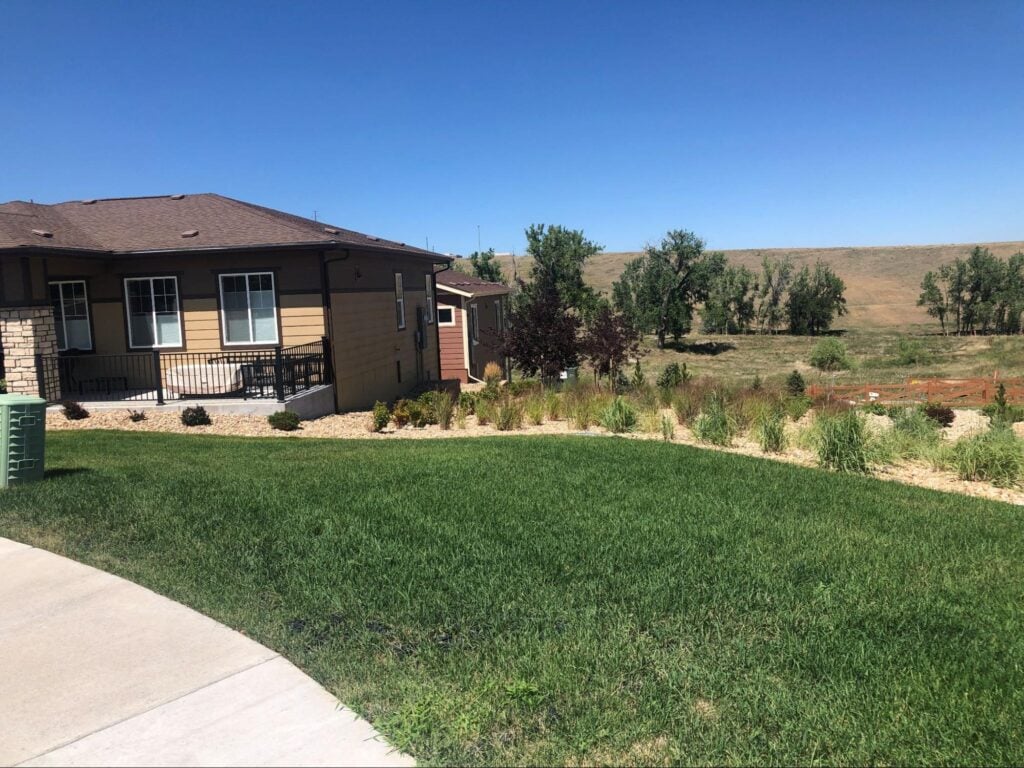
In this article, we will discuss everything you need to know about grass protection mesh for car parking, including why it’s necessary as well as some benefits that might surprise you. Let’s dive in!
What is Grass Protection Mesh for Car Parking?
Grass protection mesh, a technological innovation in modern environmental design, is a resilient recycled plastic grid system that is placed directly onto grass. It is an innovative solution that offers a sturdy yet almost invisible layer of protection, capable of supporting the weight of vehicles while also safeguarding the grass underneath.
Imagine parking your car on the lawn, and instead of causing damage, you’re helping it grow stronger. That’s what the grass protection mesh for car parking offers. Parking your car directly on the grass can compact the soil, stunt the grass growth, and leave behind ruts that could be difficult to repair. With grass protection mesh, your lawn stays as pristine as ever, even with cars parked on top of it.
Times When Overflow Grass Parking is a Necessity
Not sure if this applies to you? Life often demands flexibility, and your property is no exception. There are countless instances where you might need extra parking, including:
- Family and friends get-togethers
- Outdoor weddings and parties
- Neighborhood meetings
- Open houses during property sale
- Seasonal events like community yard sales or holiday parties
Permeable grass protection mesh is an ally that is a practical solution for overflow parking without compromising on aesthetics or grass health. To keep your grass in tip-top shape no matter the event or time of year, permeable grass mesh protection might be the solution!
What Are Permeable Pavers?
Permeable pavers are utilized in the landscape industry in order to provide an environmentally-friendly substitute to traditional paving methods. They are designed to allow water to filter through their surface, to prevent runoff and help with groundwater.
Constructed from materials such as concrete or recycled plastic, permeable pavers have interlocking gaps that enable water to drain through them, which makes them a smart choice for sustainable landscaping. Permeable pavers contribute to efficient water management, reduce soil erosion, and promote healthier vegetation due to improved soil moisture.
Introducing TRUEGRID® ROOT®
If you’re looking for cutting-edge landscaping and grass protection technology, look no further than TRUEGRID® ROOT®, a groundbreaking product from the world’s leading permeable paver company. With its advanced patented design, TRUEGRID® ROOT® dramatically raises the bar for grass protection mesh.
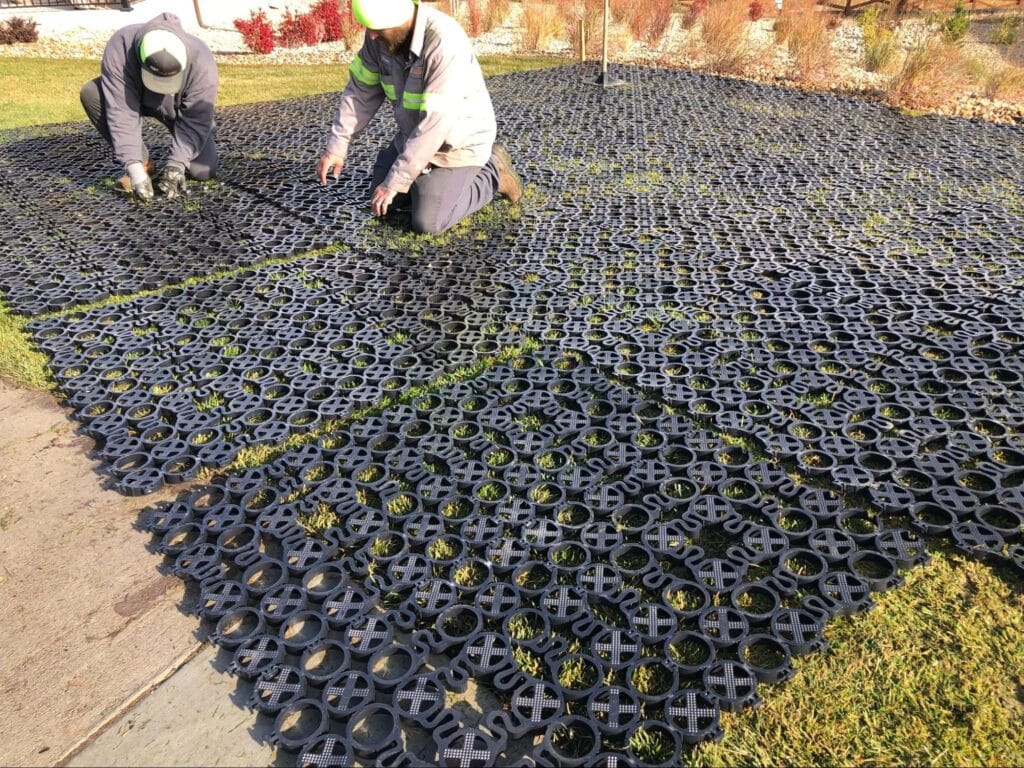
This unique solution isn’t just an innovative design that promotes grass stabilization without excavation. Its benefits go far beyond a swift and simple installation process over existing grass. The real magic lies in the benefits on multiple levels, including:
Affordability
TRUEGRID® ROOT®is one of the least expensive, but highly effective paving options on the market. Traditional paving methods can hit your wallet hard, but when you choose ROOT®, you get an affordable and sustainable solution without compromising performance or durability.
Natural Grass Preservation
By using TRUEGRID® ROOT®, you’re able to preserve the natural look and feel of your lawn, no matter how often you deal with overflow parking. The product design allows grass to grow through it, to provide a natural grass surface without any ruts, and help ensure that your lawn retains its lush, green appeal.
No Permits Needed
Since TRUEGRID® ROOT® installs over existing grass, there’s no need for installation or landscaping permits. This saves time and money, and allows you to focus on what matters – protecting your lawn.
Durability and Longevity
TRUEGRID® ROOT® is designed to withstand heavy loads and is built to last. It has an impressive 60-year lifespan to deliver unrivaled durability, and provide you with peace of mind for decades to come.
Environmentally-Friendly
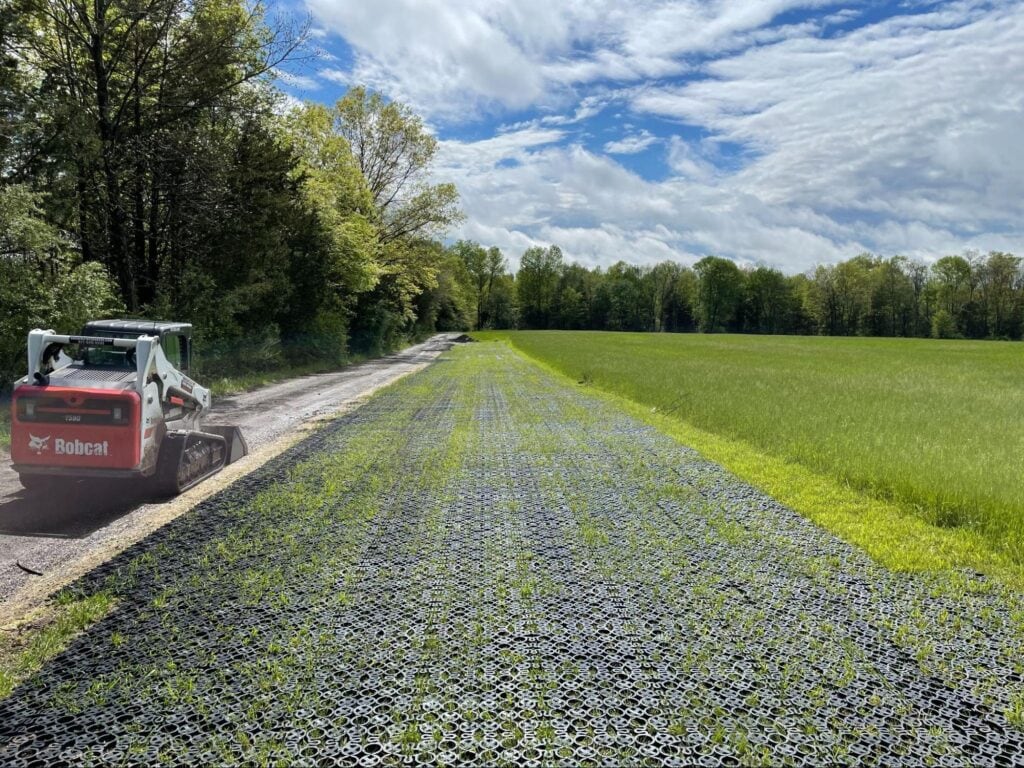
TRUEGRID® ROOT® is made from 100% recycled plastic. By choosing this product, you’re protecting your lawn and contributing to environmental sustainability.
TRUEGRID® ROOT® is much more than just a grass protection mesh for car parking. It is extremely versatile and can be utilized in a bunch of different ways, from constructing light aircraft runways to protecting festival sites, paving paths and trails, providing slope and scour protection, or supporting fairground turf. The potential uses for the TRUEGRID® ROOT® permeable paving system are virtually limitless.
Upgrade Your Overflow Parking Today with TRUEGRID® ROOT®
Don’t settle for unsightly ruts and damaged grass caused by overflow parking. Embrace the future with TRUEGRID® ROOT®, the ultimate solution in grass protection mesh for car parking.
TRUEGOOD® ROOT® will help ensure that your lawn stays as vibrant and healthy as ever, regardless of how many vehicles you need to accommodate. Its benefits go far beyond just cars and trucks, and covers a broad range of applications, including light aircraft, event spaces, and more.
Don’t wait to protect your precious green space. Get an estimate for your project today and let TRUEGRID® ROOT® transform the way you think about overflow parking.

